Leadership and Followership: Boston ICA Case Study, Module Analysis
VerifiedAdded on 2022/09/12
|11
|3244
|23
Case Study
AI Summary
This case study analyzes the leadership of Jill Medvedow in the transformation of the Boston Institute of Contemporary Art (ICA). It examines Medvedow's effective utilization of power and influence to establish a vision-driven team and foster a strong leader-follower relationship. The analysis highlights how Medvedow's strategies helped the ICA secure resources and attract visitors, emphasizing the importance of adapting leadership skills to meet employee needs. The study explores the impact of leader-follower relationships on organizational effectiveness and the achievement of strategic goals, referencing relevant leadership theories and research. It also discusses the factors essential for a healthy leader-follower dynamic, such as trust and courageous decision-making, and how these contribute to organizational success and employee retention.
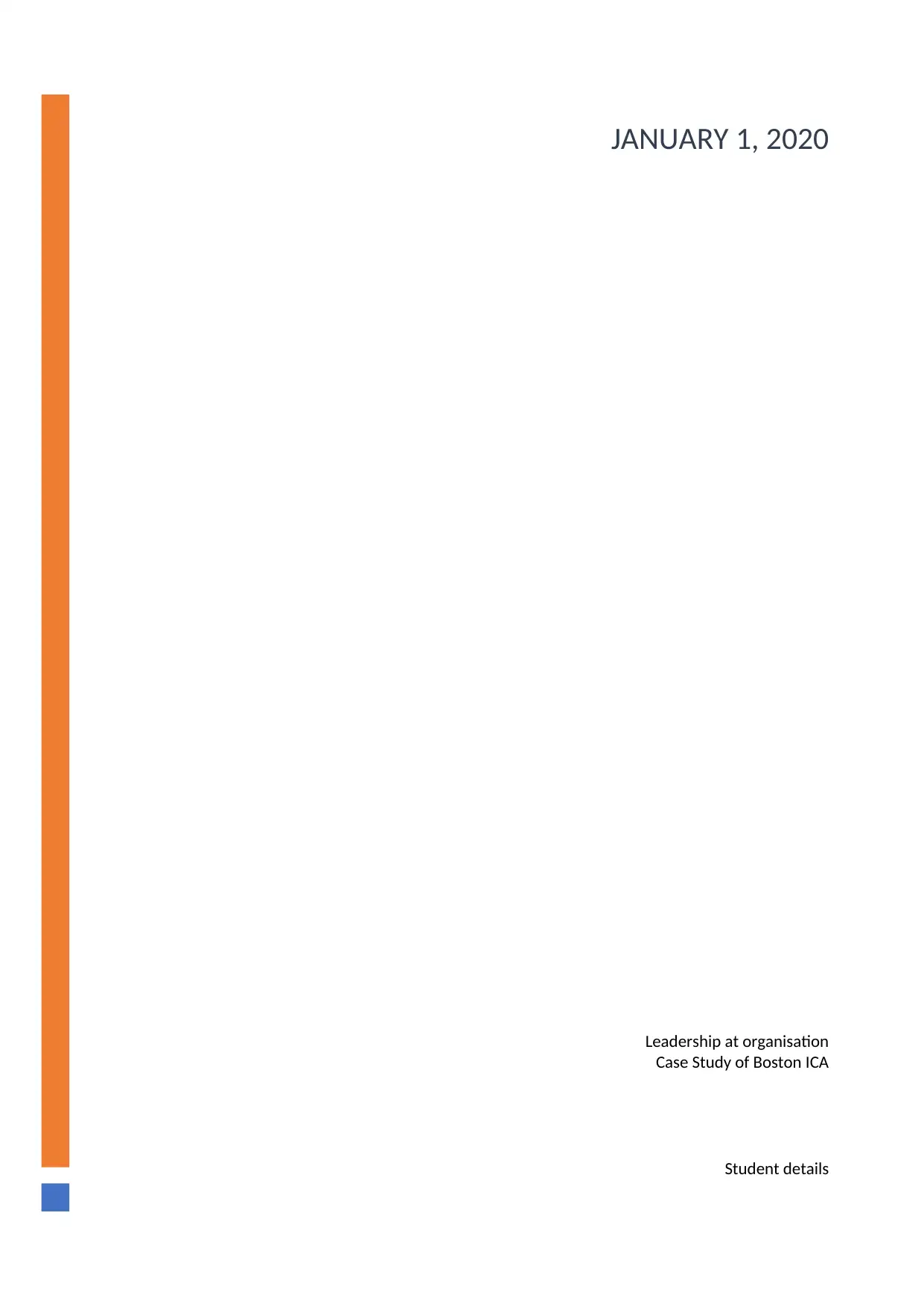
Leadership at organisation
Case Study of Boston ICA
Student details
JANUARY 1, 2020
Case Study of Boston ICA
Student details
JANUARY 1, 2020
Paraphrase This Document
Need a fresh take? Get an instant paraphrase of this document with our AI Paraphraser
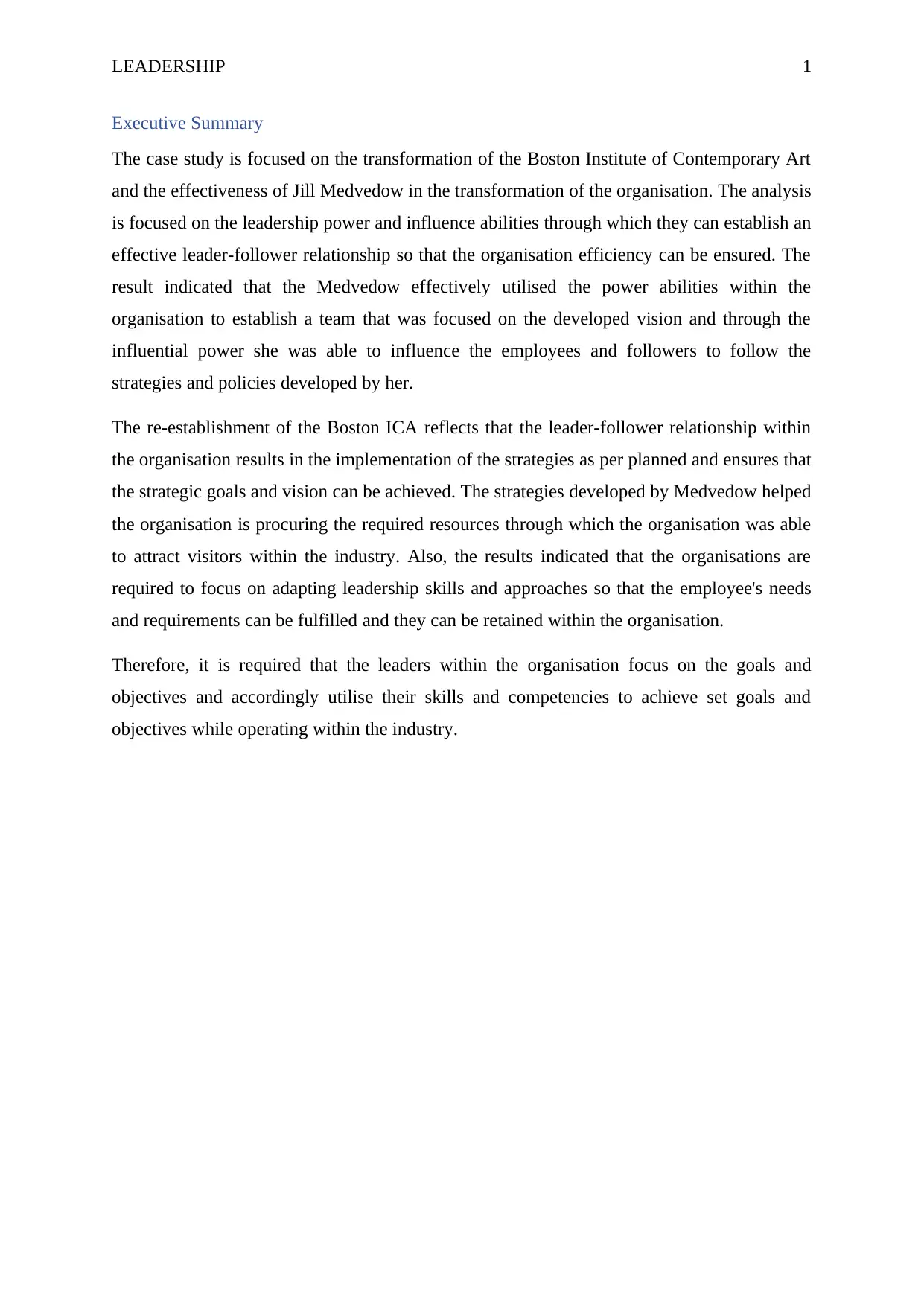
LEADERSHIP 1
Executive Summary
The case study is focused on the transformation of the Boston Institute of Contemporary Art
and the effectiveness of Jill Medvedow in the transformation of the organisation. The analysis
is focused on the leadership power and influence abilities through which they can establish an
effective leader-follower relationship so that the organisation efficiency can be ensured. The
result indicated that the Medvedow effectively utilised the power abilities within the
organisation to establish a team that was focused on the developed vision and through the
influential power she was able to influence the employees and followers to follow the
strategies and policies developed by her.
The re-establishment of the Boston ICA reflects that the leader-follower relationship within
the organisation results in the implementation of the strategies as per planned and ensures that
the strategic goals and vision can be achieved. The strategies developed by Medvedow helped
the organisation is procuring the required resources through which the organisation was able
to attract visitors within the industry. Also, the results indicated that the organisations are
required to focus on adapting leadership skills and approaches so that the employee's needs
and requirements can be fulfilled and they can be retained within the organisation.
Therefore, it is required that the leaders within the organisation focus on the goals and
objectives and accordingly utilise their skills and competencies to achieve set goals and
objectives while operating within the industry.
Executive Summary
The case study is focused on the transformation of the Boston Institute of Contemporary Art
and the effectiveness of Jill Medvedow in the transformation of the organisation. The analysis
is focused on the leadership power and influence abilities through which they can establish an
effective leader-follower relationship so that the organisation efficiency can be ensured. The
result indicated that the Medvedow effectively utilised the power abilities within the
organisation to establish a team that was focused on the developed vision and through the
influential power she was able to influence the employees and followers to follow the
strategies and policies developed by her.
The re-establishment of the Boston ICA reflects that the leader-follower relationship within
the organisation results in the implementation of the strategies as per planned and ensures that
the strategic goals and vision can be achieved. The strategies developed by Medvedow helped
the organisation is procuring the required resources through which the organisation was able
to attract visitors within the industry. Also, the results indicated that the organisations are
required to focus on adapting leadership skills and approaches so that the employee's needs
and requirements can be fulfilled and they can be retained within the organisation.
Therefore, it is required that the leaders within the organisation focus on the goals and
objectives and accordingly utilise their skills and competencies to achieve set goals and
objectives while operating within the industry.
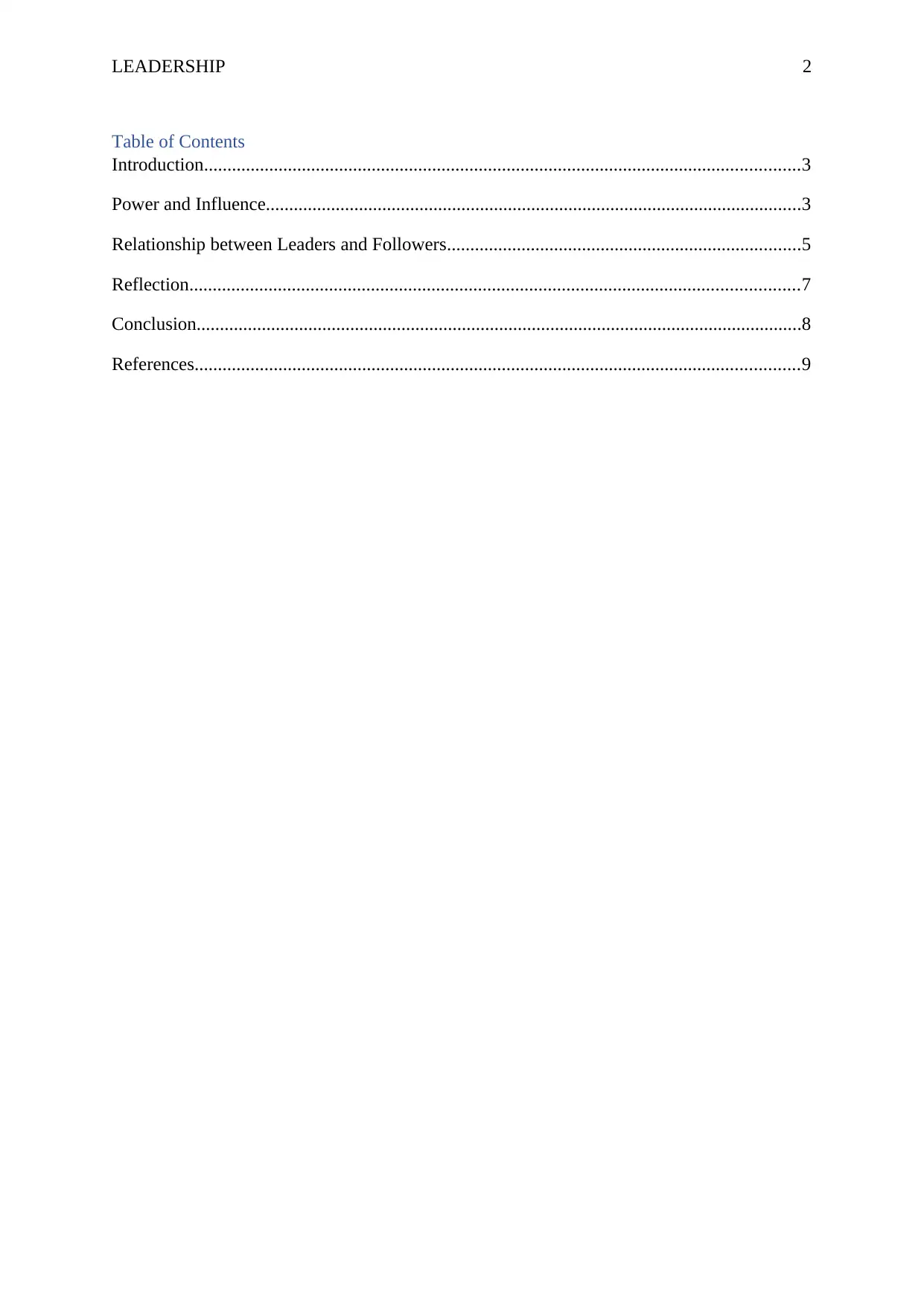
LEADERSHIP 2
Table of Contents
Introduction................................................................................................................................3
Power and Influence...................................................................................................................3
Relationship between Leaders and Followers............................................................................5
Reflection...................................................................................................................................7
Conclusion..................................................................................................................................8
References..................................................................................................................................9
Table of Contents
Introduction................................................................................................................................3
Power and Influence...................................................................................................................3
Relationship between Leaders and Followers............................................................................5
Reflection...................................................................................................................................7
Conclusion..................................................................................................................................8
References..................................................................................................................................9
⊘ This is a preview!⊘
Do you want full access?
Subscribe today to unlock all pages.

Trusted by 1+ million students worldwide
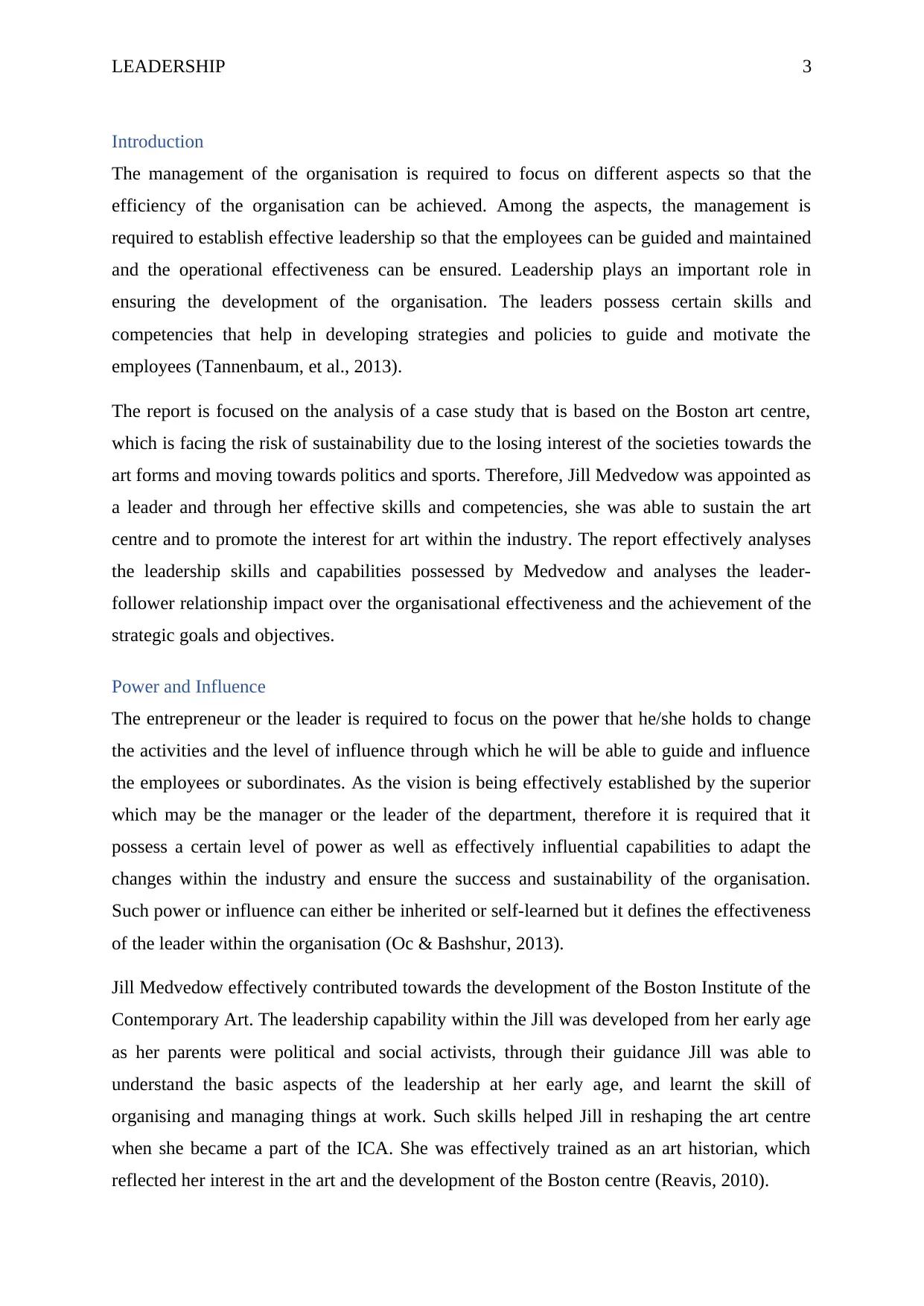
LEADERSHIP 3
Introduction
The management of the organisation is required to focus on different aspects so that the
efficiency of the organisation can be achieved. Among the aspects, the management is
required to establish effective leadership so that the employees can be guided and maintained
and the operational effectiveness can be ensured. Leadership plays an important role in
ensuring the development of the organisation. The leaders possess certain skills and
competencies that help in developing strategies and policies to guide and motivate the
employees (Tannenbaum, et al., 2013).
The report is focused on the analysis of a case study that is based on the Boston art centre,
which is facing the risk of sustainability due to the losing interest of the societies towards the
art forms and moving towards politics and sports. Therefore, Jill Medvedow was appointed as
a leader and through her effective skills and competencies, she was able to sustain the art
centre and to promote the interest for art within the industry. The report effectively analyses
the leadership skills and capabilities possessed by Medvedow and analyses the leader-
follower relationship impact over the organisational effectiveness and the achievement of the
strategic goals and objectives.
Power and Influence
The entrepreneur or the leader is required to focus on the power that he/she holds to change
the activities and the level of influence through which he will be able to guide and influence
the employees or subordinates. As the vision is being effectively established by the superior
which may be the manager or the leader of the department, therefore it is required that it
possess a certain level of power as well as effectively influential capabilities to adapt the
changes within the industry and ensure the success and sustainability of the organisation.
Such power or influence can either be inherited or self-learned but it defines the effectiveness
of the leader within the organisation (Oc & Bashshur, 2013).
Jill Medvedow effectively contributed towards the development of the Boston Institute of the
Contemporary Art. The leadership capability within the Jill was developed from her early age
as her parents were political and social activists, through their guidance Jill was able to
understand the basic aspects of the leadership at her early age, and learnt the skill of
organising and managing things at work. Such skills helped Jill in reshaping the art centre
when she became a part of the ICA. She was effectively trained as an art historian, which
reflected her interest in the art and the development of the Boston centre (Reavis, 2010).
Introduction
The management of the organisation is required to focus on different aspects so that the
efficiency of the organisation can be achieved. Among the aspects, the management is
required to establish effective leadership so that the employees can be guided and maintained
and the operational effectiveness can be ensured. Leadership plays an important role in
ensuring the development of the organisation. The leaders possess certain skills and
competencies that help in developing strategies and policies to guide and motivate the
employees (Tannenbaum, et al., 2013).
The report is focused on the analysis of a case study that is based on the Boston art centre,
which is facing the risk of sustainability due to the losing interest of the societies towards the
art forms and moving towards politics and sports. Therefore, Jill Medvedow was appointed as
a leader and through her effective skills and competencies, she was able to sustain the art
centre and to promote the interest for art within the industry. The report effectively analyses
the leadership skills and capabilities possessed by Medvedow and analyses the leader-
follower relationship impact over the organisational effectiveness and the achievement of the
strategic goals and objectives.
Power and Influence
The entrepreneur or the leader is required to focus on the power that he/she holds to change
the activities and the level of influence through which he will be able to guide and influence
the employees or subordinates. As the vision is being effectively established by the superior
which may be the manager or the leader of the department, therefore it is required that it
possess a certain level of power as well as effectively influential capabilities to adapt the
changes within the industry and ensure the success and sustainability of the organisation.
Such power or influence can either be inherited or self-learned but it defines the effectiveness
of the leader within the organisation (Oc & Bashshur, 2013).
Jill Medvedow effectively contributed towards the development of the Boston Institute of the
Contemporary Art. The leadership capability within the Jill was developed from her early age
as her parents were political and social activists, through their guidance Jill was able to
understand the basic aspects of the leadership at her early age, and learnt the skill of
organising and managing things at work. Such skills helped Jill in reshaping the art centre
when she became a part of the ICA. She was effectively trained as an art historian, which
reflected her interest in the art and the development of the Boston centre (Reavis, 2010).
Paraphrase This Document
Need a fresh take? Get an instant paraphrase of this document with our AI Paraphraser
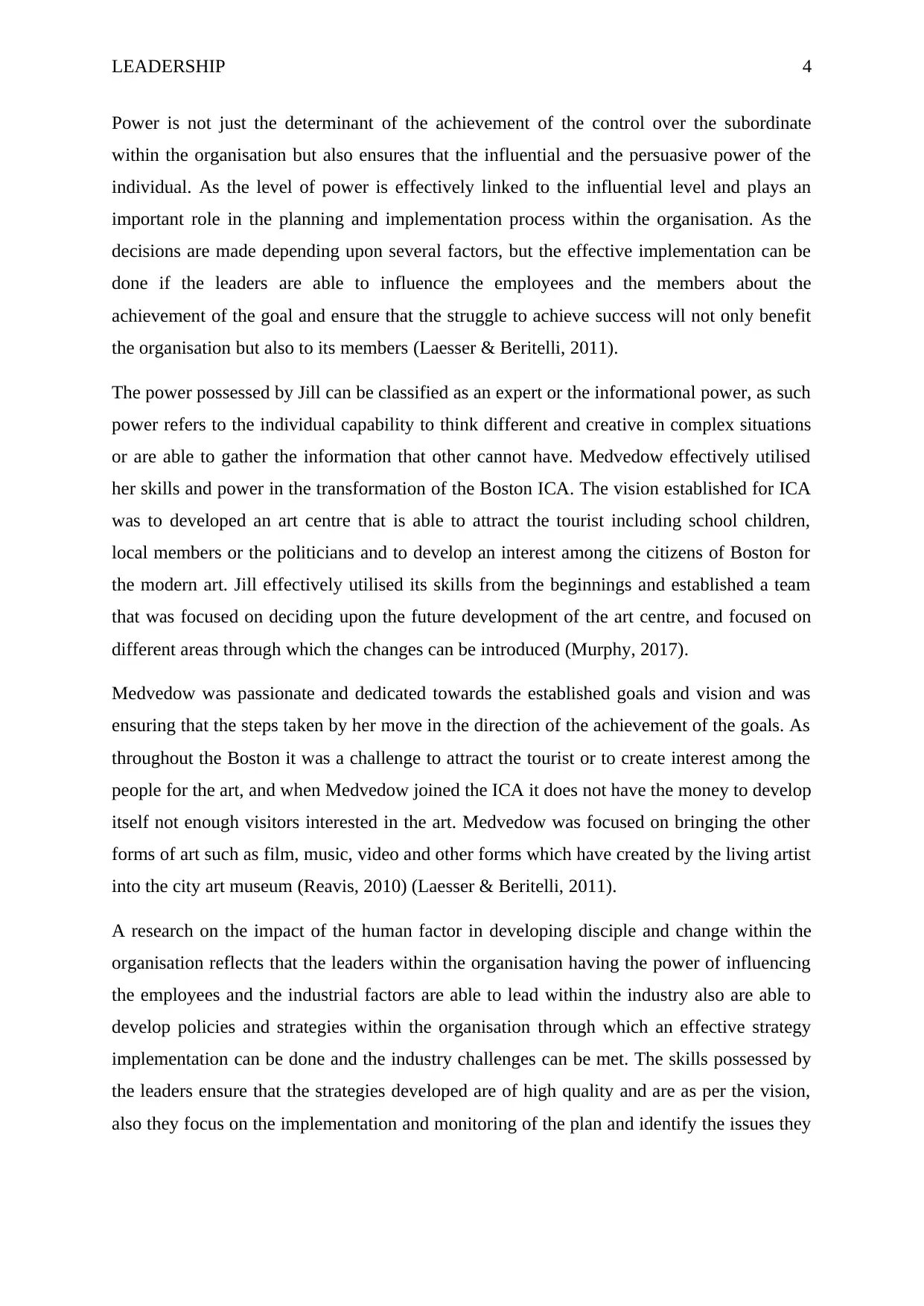
LEADERSHIP 4
Power is not just the determinant of the achievement of the control over the subordinate
within the organisation but also ensures that the influential and the persuasive power of the
individual. As the level of power is effectively linked to the influential level and plays an
important role in the planning and implementation process within the organisation. As the
decisions are made depending upon several factors, but the effective implementation can be
done if the leaders are able to influence the employees and the members about the
achievement of the goal and ensure that the struggle to achieve success will not only benefit
the organisation but also to its members (Laesser & Beritelli, 2011).
The power possessed by Jill can be classified as an expert or the informational power, as such
power refers to the individual capability to think different and creative in complex situations
or are able to gather the information that other cannot have. Medvedow effectively utilised
her skills and power in the transformation of the Boston ICA. The vision established for ICA
was to developed an art centre that is able to attract the tourist including school children,
local members or the politicians and to develop an interest among the citizens of Boston for
the modern art. Jill effectively utilised its skills from the beginnings and established a team
that was focused on deciding upon the future development of the art centre, and focused on
different areas through which the changes can be introduced (Murphy, 2017).
Medvedow was passionate and dedicated towards the established goals and vision and was
ensuring that the steps taken by her move in the direction of the achievement of the goals. As
throughout the Boston it was a challenge to attract the tourist or to create interest among the
people for the art, and when Medvedow joined the ICA it does not have the money to develop
itself not enough visitors interested in the art. Medvedow was focused on bringing the other
forms of art such as film, music, video and other forms which have created by the living artist
into the city art museum (Reavis, 2010) (Laesser & Beritelli, 2011).
A research on the impact of the human factor in developing disciple and change within the
organisation reflects that the leaders within the organisation having the power of influencing
the employees and the industrial factors are able to lead within the industry also are able to
develop policies and strategies within the organisation through which an effective strategy
implementation can be done and the industry challenges can be met. The skills possessed by
the leaders ensure that the strategies developed are of high quality and are as per the vision,
also they focus on the implementation and monitoring of the plan and identify the issues they
Power is not just the determinant of the achievement of the control over the subordinate
within the organisation but also ensures that the influential and the persuasive power of the
individual. As the level of power is effectively linked to the influential level and plays an
important role in the planning and implementation process within the organisation. As the
decisions are made depending upon several factors, but the effective implementation can be
done if the leaders are able to influence the employees and the members about the
achievement of the goal and ensure that the struggle to achieve success will not only benefit
the organisation but also to its members (Laesser & Beritelli, 2011).
The power possessed by Jill can be classified as an expert or the informational power, as such
power refers to the individual capability to think different and creative in complex situations
or are able to gather the information that other cannot have. Medvedow effectively utilised
her skills and power in the transformation of the Boston ICA. The vision established for ICA
was to developed an art centre that is able to attract the tourist including school children,
local members or the politicians and to develop an interest among the citizens of Boston for
the modern art. Jill effectively utilised its skills from the beginnings and established a team
that was focused on deciding upon the future development of the art centre, and focused on
different areas through which the changes can be introduced (Murphy, 2017).
Medvedow was passionate and dedicated towards the established goals and vision and was
ensuring that the steps taken by her move in the direction of the achievement of the goals. As
throughout the Boston it was a challenge to attract the tourist or to create interest among the
people for the art, and when Medvedow joined the ICA it does not have the money to develop
itself not enough visitors interested in the art. Medvedow was focused on bringing the other
forms of art such as film, music, video and other forms which have created by the living artist
into the city art museum (Reavis, 2010) (Laesser & Beritelli, 2011).
A research on the impact of the human factor in developing disciple and change within the
organisation reflects that the leaders within the organisation having the power of influencing
the employees and the industrial factors are able to lead within the industry also are able to
develop policies and strategies within the organisation through which an effective strategy
implementation can be done and the industry challenges can be met. The skills possessed by
the leaders ensure that the strategies developed are of high quality and are as per the vision,
also they focus on the implementation and monitoring of the plan and identify the issues they
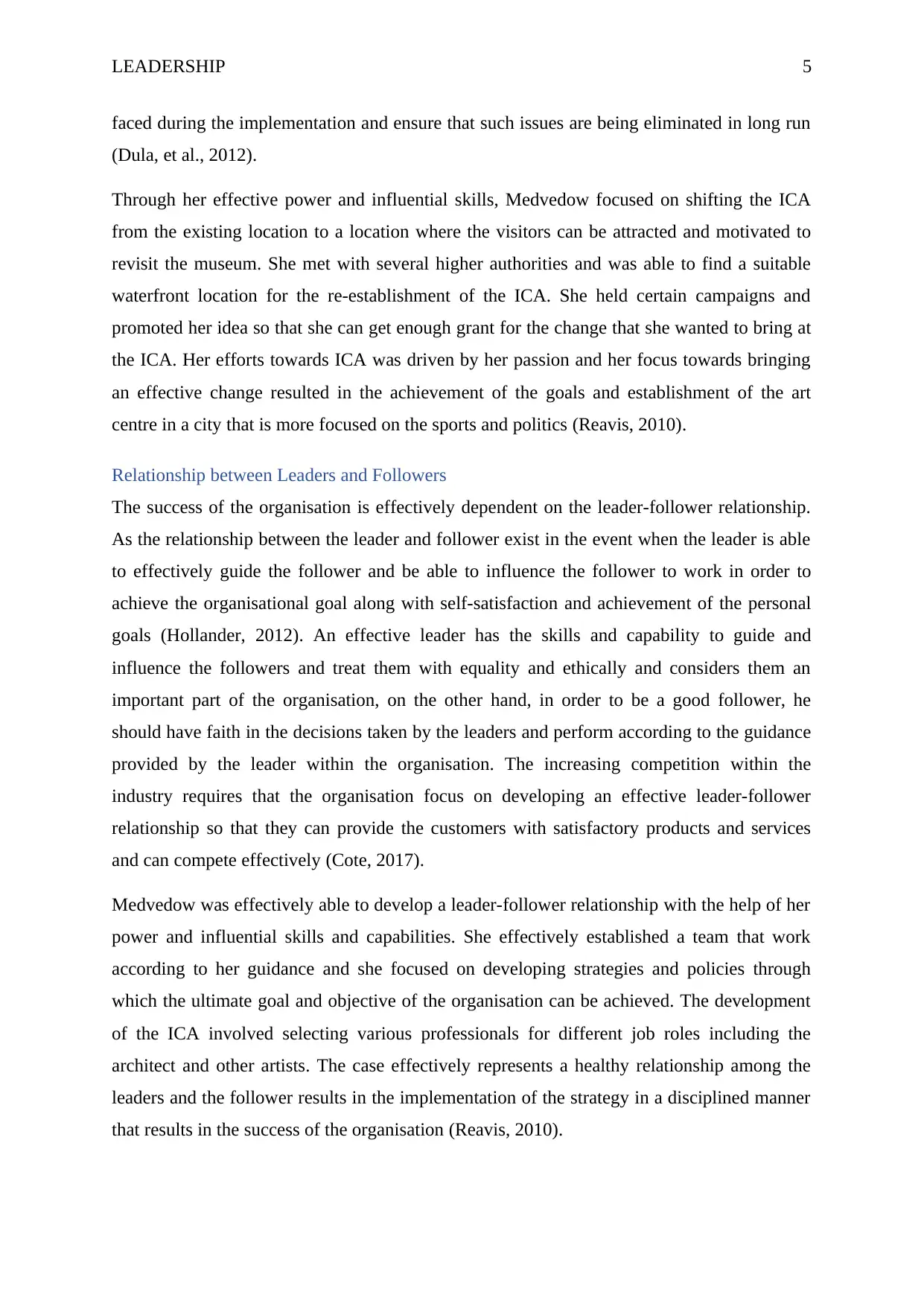
LEADERSHIP 5
faced during the implementation and ensure that such issues are being eliminated in long run
(Dula, et al., 2012).
Through her effective power and influential skills, Medvedow focused on shifting the ICA
from the existing location to a location where the visitors can be attracted and motivated to
revisit the museum. She met with several higher authorities and was able to find a suitable
waterfront location for the re-establishment of the ICA. She held certain campaigns and
promoted her idea so that she can get enough grant for the change that she wanted to bring at
the ICA. Her efforts towards ICA was driven by her passion and her focus towards bringing
an effective change resulted in the achievement of the goals and establishment of the art
centre in a city that is more focused on the sports and politics (Reavis, 2010).
Relationship between Leaders and Followers
The success of the organisation is effectively dependent on the leader-follower relationship.
As the relationship between the leader and follower exist in the event when the leader is able
to effectively guide the follower and be able to influence the follower to work in order to
achieve the organisational goal along with self-satisfaction and achievement of the personal
goals (Hollander, 2012). An effective leader has the skills and capability to guide and
influence the followers and treat them with equality and ethically and considers them an
important part of the organisation, on the other hand, in order to be a good follower, he
should have faith in the decisions taken by the leaders and perform according to the guidance
provided by the leader within the organisation. The increasing competition within the
industry requires that the organisation focus on developing an effective leader-follower
relationship so that they can provide the customers with satisfactory products and services
and can compete effectively (Cote, 2017).
Medvedow was effectively able to develop a leader-follower relationship with the help of her
power and influential skills and capabilities. She effectively established a team that work
according to her guidance and she focused on developing strategies and policies through
which the ultimate goal and objective of the organisation can be achieved. The development
of the ICA involved selecting various professionals for different job roles including the
architect and other artists. The case effectively represents a healthy relationship among the
leaders and the follower results in the implementation of the strategy in a disciplined manner
that results in the success of the organisation (Reavis, 2010).
faced during the implementation and ensure that such issues are being eliminated in long run
(Dula, et al., 2012).
Through her effective power and influential skills, Medvedow focused on shifting the ICA
from the existing location to a location where the visitors can be attracted and motivated to
revisit the museum. She met with several higher authorities and was able to find a suitable
waterfront location for the re-establishment of the ICA. She held certain campaigns and
promoted her idea so that she can get enough grant for the change that she wanted to bring at
the ICA. Her efforts towards ICA was driven by her passion and her focus towards bringing
an effective change resulted in the achievement of the goals and establishment of the art
centre in a city that is more focused on the sports and politics (Reavis, 2010).
Relationship between Leaders and Followers
The success of the organisation is effectively dependent on the leader-follower relationship.
As the relationship between the leader and follower exist in the event when the leader is able
to effectively guide the follower and be able to influence the follower to work in order to
achieve the organisational goal along with self-satisfaction and achievement of the personal
goals (Hollander, 2012). An effective leader has the skills and capability to guide and
influence the followers and treat them with equality and ethically and considers them an
important part of the organisation, on the other hand, in order to be a good follower, he
should have faith in the decisions taken by the leaders and perform according to the guidance
provided by the leader within the organisation. The increasing competition within the
industry requires that the organisation focus on developing an effective leader-follower
relationship so that they can provide the customers with satisfactory products and services
and can compete effectively (Cote, 2017).
Medvedow was effectively able to develop a leader-follower relationship with the help of her
power and influential skills and capabilities. She effectively established a team that work
according to her guidance and she focused on developing strategies and policies through
which the ultimate goal and objective of the organisation can be achieved. The development
of the ICA involved selecting various professionals for different job roles including the
architect and other artists. The case effectively represents a healthy relationship among the
leaders and the follower results in the implementation of the strategy in a disciplined manner
that results in the success of the organisation (Reavis, 2010).
⊘ This is a preview!⊘
Do you want full access?
Subscribe today to unlock all pages.

Trusted by 1+ million students worldwide
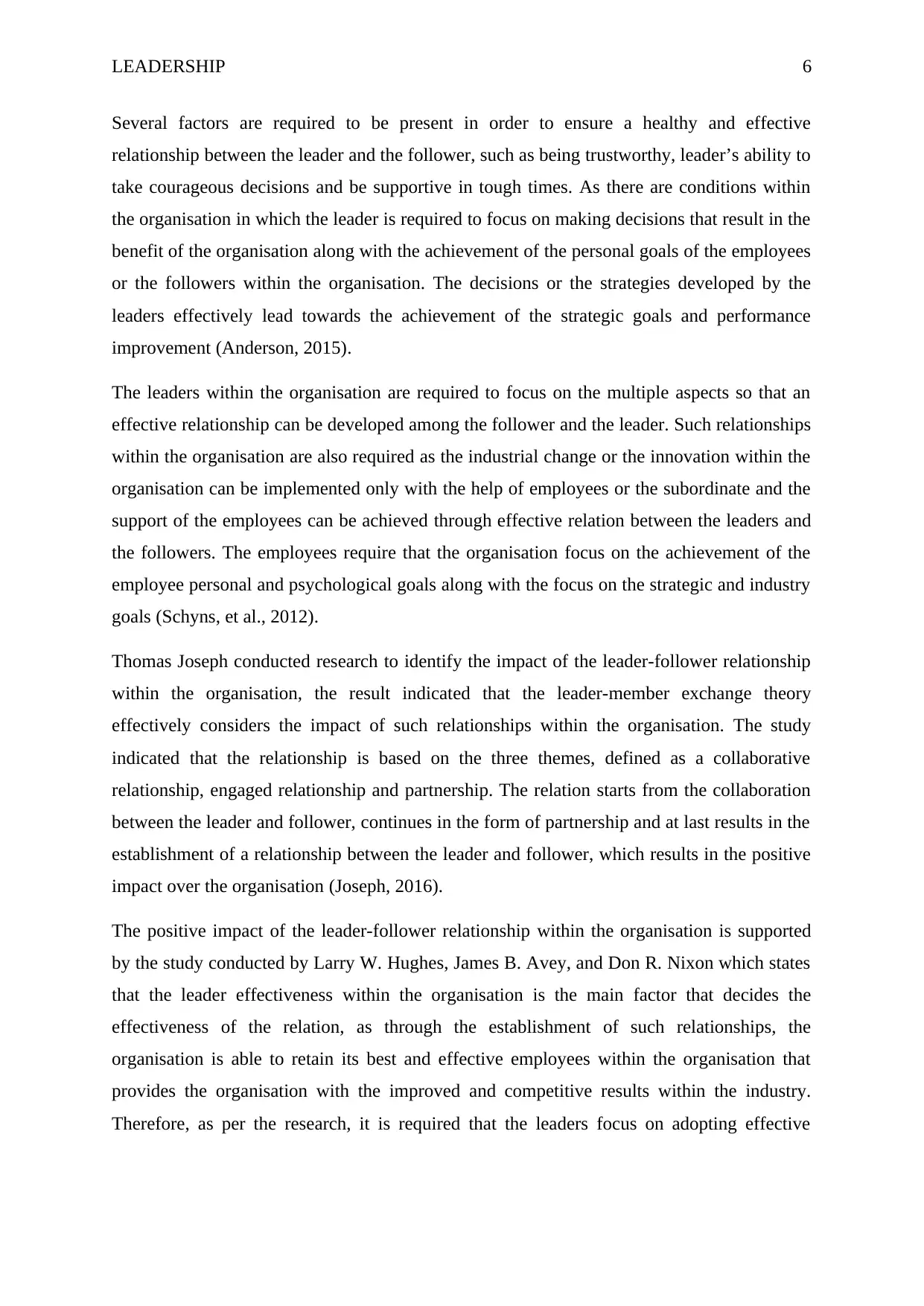
LEADERSHIP 6
Several factors are required to be present in order to ensure a healthy and effective
relationship between the leader and the follower, such as being trustworthy, leader’s ability to
take courageous decisions and be supportive in tough times. As there are conditions within
the organisation in which the leader is required to focus on making decisions that result in the
benefit of the organisation along with the achievement of the personal goals of the employees
or the followers within the organisation. The decisions or the strategies developed by the
leaders effectively lead towards the achievement of the strategic goals and performance
improvement (Anderson, 2015).
The leaders within the organisation are required to focus on the multiple aspects so that an
effective relationship can be developed among the follower and the leader. Such relationships
within the organisation are also required as the industrial change or the innovation within the
organisation can be implemented only with the help of employees or the subordinate and the
support of the employees can be achieved through effective relation between the leaders and
the followers. The employees require that the organisation focus on the achievement of the
employee personal and psychological goals along with the focus on the strategic and industry
goals (Schyns, et al., 2012).
Thomas Joseph conducted research to identify the impact of the leader-follower relationship
within the organisation, the result indicated that the leader-member exchange theory
effectively considers the impact of such relationships within the organisation. The study
indicated that the relationship is based on the three themes, defined as a collaborative
relationship, engaged relationship and partnership. The relation starts from the collaboration
between the leader and follower, continues in the form of partnership and at last results in the
establishment of a relationship between the leader and follower, which results in the positive
impact over the organisation (Joseph, 2016).
The positive impact of the leader-follower relationship within the organisation is supported
by the study conducted by Larry W. Hughes, James B. Avey, and Don R. Nixon which states
that the leader effectiveness within the organisation is the main factor that decides the
effectiveness of the relation, as through the establishment of such relationships, the
organisation is able to retain its best and effective employees within the organisation that
provides the organisation with the improved and competitive results within the industry.
Therefore, as per the research, it is required that the leaders focus on adopting effective
Several factors are required to be present in order to ensure a healthy and effective
relationship between the leader and the follower, such as being trustworthy, leader’s ability to
take courageous decisions and be supportive in tough times. As there are conditions within
the organisation in which the leader is required to focus on making decisions that result in the
benefit of the organisation along with the achievement of the personal goals of the employees
or the followers within the organisation. The decisions or the strategies developed by the
leaders effectively lead towards the achievement of the strategic goals and performance
improvement (Anderson, 2015).
The leaders within the organisation are required to focus on the multiple aspects so that an
effective relationship can be developed among the follower and the leader. Such relationships
within the organisation are also required as the industrial change or the innovation within the
organisation can be implemented only with the help of employees or the subordinate and the
support of the employees can be achieved through effective relation between the leaders and
the followers. The employees require that the organisation focus on the achievement of the
employee personal and psychological goals along with the focus on the strategic and industry
goals (Schyns, et al., 2012).
Thomas Joseph conducted research to identify the impact of the leader-follower relationship
within the organisation, the result indicated that the leader-member exchange theory
effectively considers the impact of such relationships within the organisation. The study
indicated that the relationship is based on the three themes, defined as a collaborative
relationship, engaged relationship and partnership. The relation starts from the collaboration
between the leader and follower, continues in the form of partnership and at last results in the
establishment of a relationship between the leader and follower, which results in the positive
impact over the organisation (Joseph, 2016).
The positive impact of the leader-follower relationship within the organisation is supported
by the study conducted by Larry W. Hughes, James B. Avey, and Don R. Nixon which states
that the leader effectiveness within the organisation is the main factor that decides the
effectiveness of the relation, as through the establishment of such relationships, the
organisation is able to retain its best and effective employees within the organisation that
provides the organisation with the improved and competitive results within the industry.
Therefore, as per the research, it is required that the leaders focus on adopting effective
Paraphrase This Document
Need a fresh take? Get an instant paraphrase of this document with our AI Paraphraser
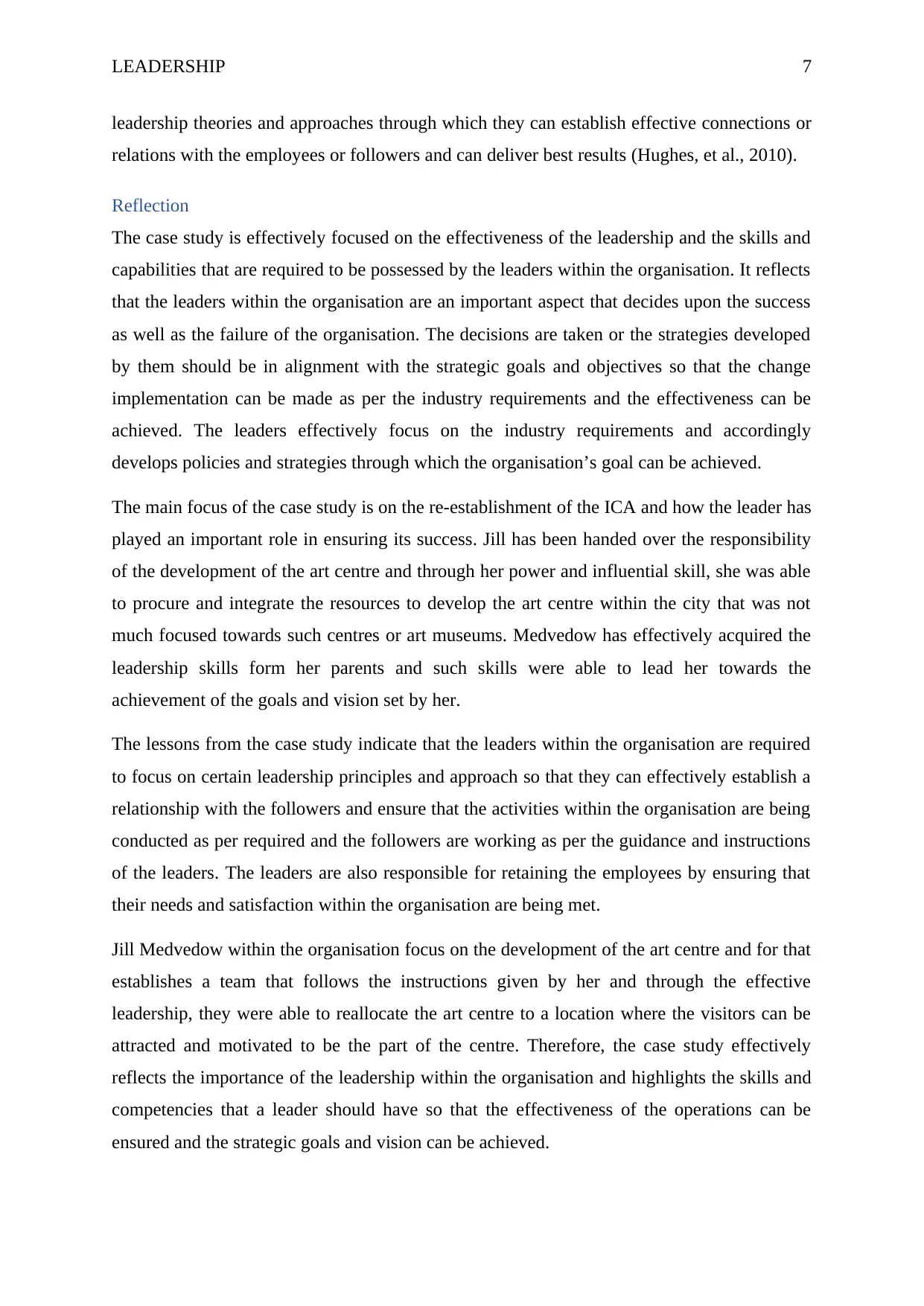
LEADERSHIP 7
leadership theories and approaches through which they can establish effective connections or
relations with the employees or followers and can deliver best results (Hughes, et al., 2010).
Reflection
The case study is effectively focused on the effectiveness of the leadership and the skills and
capabilities that are required to be possessed by the leaders within the organisation. It reflects
that the leaders within the organisation are an important aspect that decides upon the success
as well as the failure of the organisation. The decisions are taken or the strategies developed
by them should be in alignment with the strategic goals and objectives so that the change
implementation can be made as per the industry requirements and the effectiveness can be
achieved. The leaders effectively focus on the industry requirements and accordingly
develops policies and strategies through which the organisation’s goal can be achieved.
The main focus of the case study is on the re-establishment of the ICA and how the leader has
played an important role in ensuring its success. Jill has been handed over the responsibility
of the development of the art centre and through her power and influential skill, she was able
to procure and integrate the resources to develop the art centre within the city that was not
much focused towards such centres or art museums. Medvedow has effectively acquired the
leadership skills form her parents and such skills were able to lead her towards the
achievement of the goals and vision set by her.
The lessons from the case study indicate that the leaders within the organisation are required
to focus on certain leadership principles and approach so that they can effectively establish a
relationship with the followers and ensure that the activities within the organisation are being
conducted as per required and the followers are working as per the guidance and instructions
of the leaders. The leaders are also responsible for retaining the employees by ensuring that
their needs and satisfaction within the organisation are being met.
Jill Medvedow within the organisation focus on the development of the art centre and for that
establishes a team that follows the instructions given by her and through the effective
leadership, they were able to reallocate the art centre to a location where the visitors can be
attracted and motivated to be the part of the centre. Therefore, the case study effectively
reflects the importance of the leadership within the organisation and highlights the skills and
competencies that a leader should have so that the effectiveness of the operations can be
ensured and the strategic goals and vision can be achieved.
leadership theories and approaches through which they can establish effective connections or
relations with the employees or followers and can deliver best results (Hughes, et al., 2010).
Reflection
The case study is effectively focused on the effectiveness of the leadership and the skills and
capabilities that are required to be possessed by the leaders within the organisation. It reflects
that the leaders within the organisation are an important aspect that decides upon the success
as well as the failure of the organisation. The decisions are taken or the strategies developed
by them should be in alignment with the strategic goals and objectives so that the change
implementation can be made as per the industry requirements and the effectiveness can be
achieved. The leaders effectively focus on the industry requirements and accordingly
develops policies and strategies through which the organisation’s goal can be achieved.
The main focus of the case study is on the re-establishment of the ICA and how the leader has
played an important role in ensuring its success. Jill has been handed over the responsibility
of the development of the art centre and through her power and influential skill, she was able
to procure and integrate the resources to develop the art centre within the city that was not
much focused towards such centres or art museums. Medvedow has effectively acquired the
leadership skills form her parents and such skills were able to lead her towards the
achievement of the goals and vision set by her.
The lessons from the case study indicate that the leaders within the organisation are required
to focus on certain leadership principles and approach so that they can effectively establish a
relationship with the followers and ensure that the activities within the organisation are being
conducted as per required and the followers are working as per the guidance and instructions
of the leaders. The leaders are also responsible for retaining the employees by ensuring that
their needs and satisfaction within the organisation are being met.
Jill Medvedow within the organisation focus on the development of the art centre and for that
establishes a team that follows the instructions given by her and through the effective
leadership, they were able to reallocate the art centre to a location where the visitors can be
attracted and motivated to be the part of the centre. Therefore, the case study effectively
reflects the importance of the leadership within the organisation and highlights the skills and
competencies that a leader should have so that the effectiveness of the operations can be
ensured and the strategic goals and vision can be achieved.
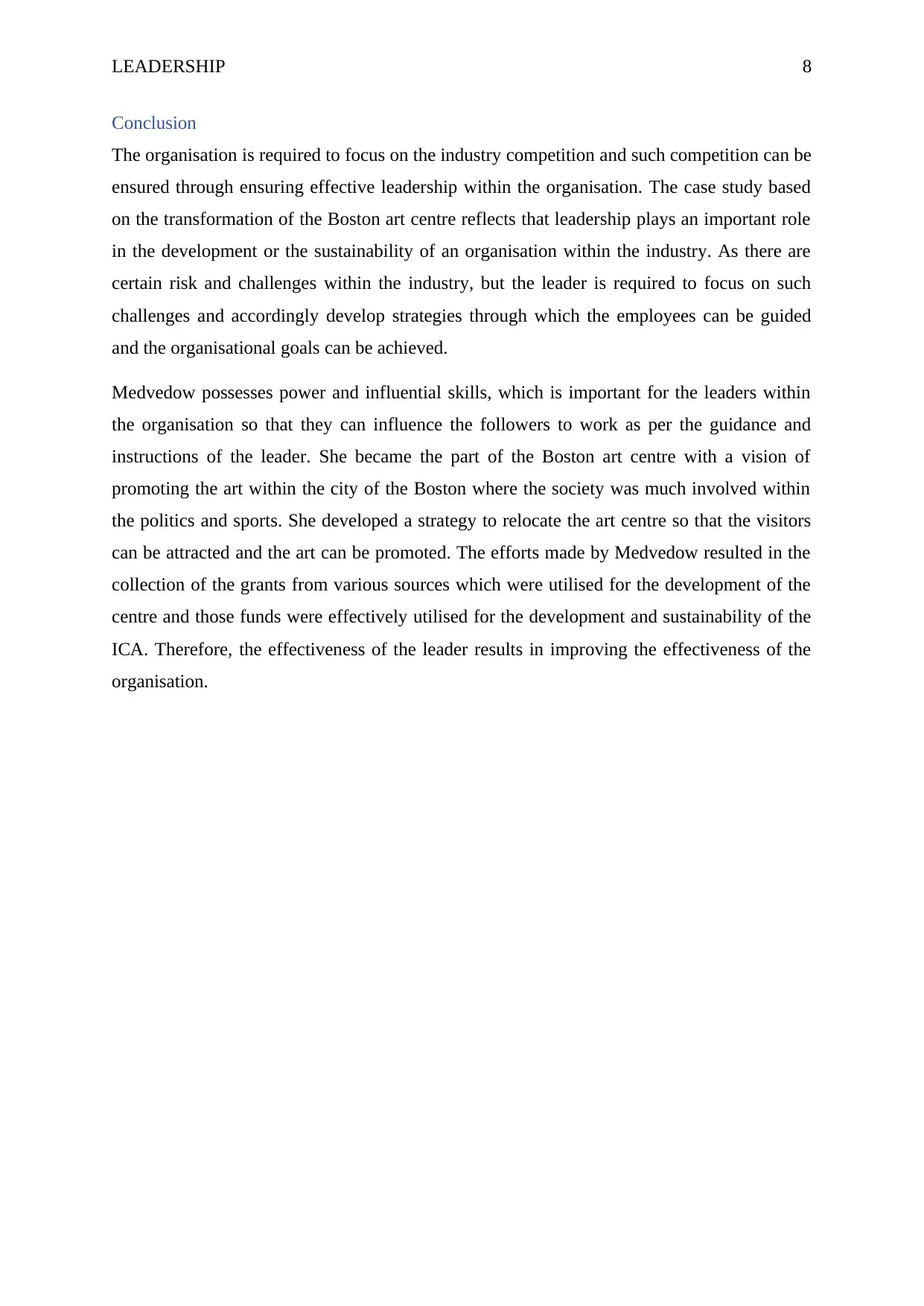
LEADERSHIP 8
Conclusion
The organisation is required to focus on the industry competition and such competition can be
ensured through ensuring effective leadership within the organisation. The case study based
on the transformation of the Boston art centre reflects that leadership plays an important role
in the development or the sustainability of an organisation within the industry. As there are
certain risk and challenges within the industry, but the leader is required to focus on such
challenges and accordingly develop strategies through which the employees can be guided
and the organisational goals can be achieved.
Medvedow possesses power and influential skills, which is important for the leaders within
the organisation so that they can influence the followers to work as per the guidance and
instructions of the leader. She became the part of the Boston art centre with a vision of
promoting the art within the city of the Boston where the society was much involved within
the politics and sports. She developed a strategy to relocate the art centre so that the visitors
can be attracted and the art can be promoted. The efforts made by Medvedow resulted in the
collection of the grants from various sources which were utilised for the development of the
centre and those funds were effectively utilised for the development and sustainability of the
ICA. Therefore, the effectiveness of the leader results in improving the effectiveness of the
organisation.
Conclusion
The organisation is required to focus on the industry competition and such competition can be
ensured through ensuring effective leadership within the organisation. The case study based
on the transformation of the Boston art centre reflects that leadership plays an important role
in the development or the sustainability of an organisation within the industry. As there are
certain risk and challenges within the industry, but the leader is required to focus on such
challenges and accordingly develop strategies through which the employees can be guided
and the organisational goals can be achieved.
Medvedow possesses power and influential skills, which is important for the leaders within
the organisation so that they can influence the followers to work as per the guidance and
instructions of the leader. She became the part of the Boston art centre with a vision of
promoting the art within the city of the Boston where the society was much involved within
the politics and sports. She developed a strategy to relocate the art centre so that the visitors
can be attracted and the art can be promoted. The efforts made by Medvedow resulted in the
collection of the grants from various sources which were utilised for the development of the
centre and those funds were effectively utilised for the development and sustainability of the
ICA. Therefore, the effectiveness of the leader results in improving the effectiveness of the
organisation.
⊘ This is a preview!⊘
Do you want full access?
Subscribe today to unlock all pages.

Trusted by 1+ million students worldwide
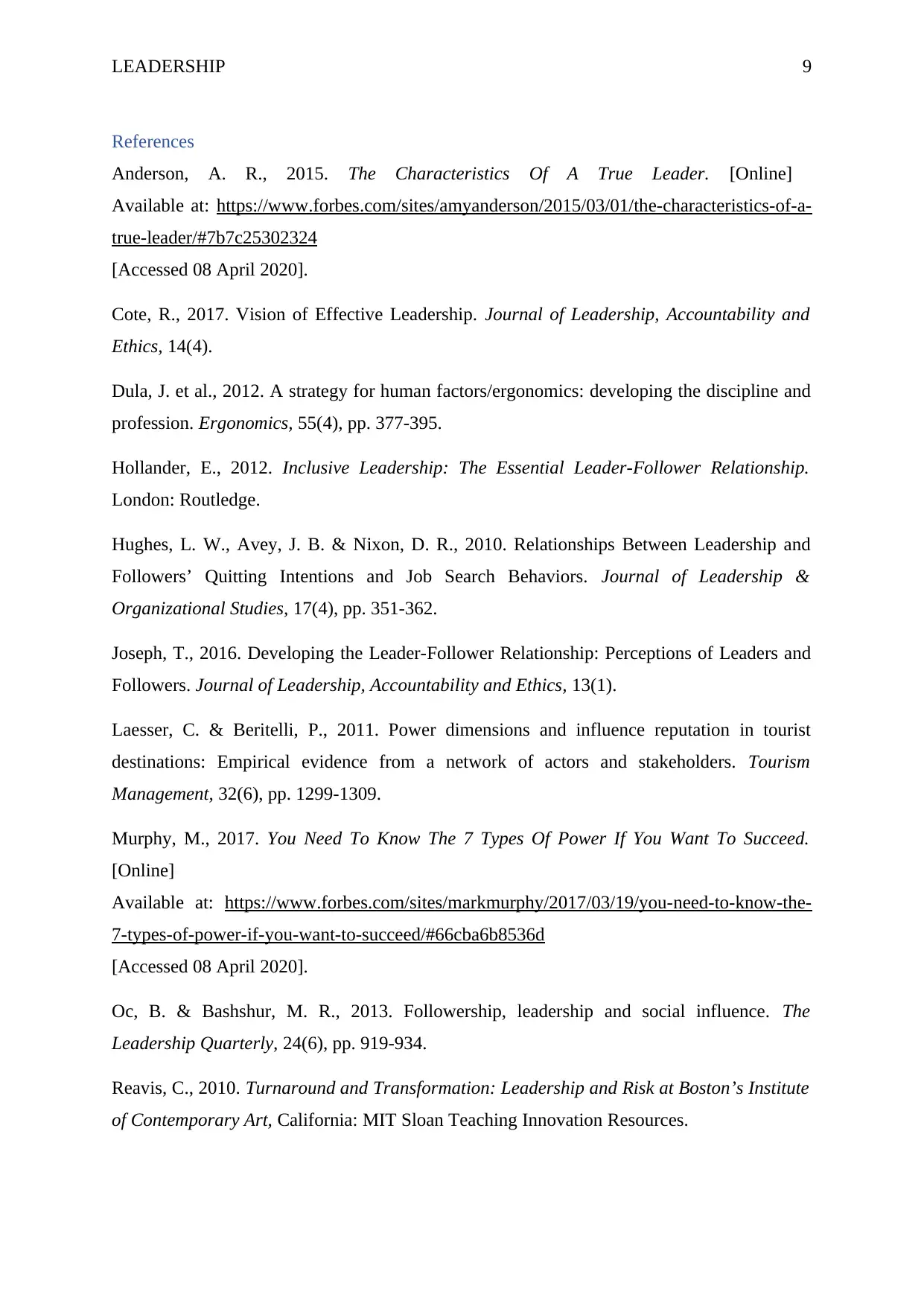
LEADERSHIP 9
References
Anderson, A. R., 2015. The Characteristics Of A True Leader. [Online]
Available at: https://www.forbes.com/sites/amyanderson/2015/03/01/the-characteristics-of-a-
true-leader/#7b7c25302324
[Accessed 08 April 2020].
Cote, R., 2017. Vision of Effective Leadership. Journal of Leadership, Accountability and
Ethics, 14(4).
Dula, J. et al., 2012. A strategy for human factors/ergonomics: developing the discipline and
profession. Ergonomics, 55(4), pp. 377-395.
Hollander, E., 2012. Inclusive Leadership: The Essential Leader-Follower Relationship.
London: Routledge.
Hughes, L. W., Avey, J. B. & Nixon, D. R., 2010. Relationships Between Leadership and
Followers’ Quitting Intentions and Job Search Behaviors. Journal of Leadership &
Organizational Studies, 17(4), pp. 351-362.
Joseph, T., 2016. Developing the Leader-Follower Relationship: Perceptions of Leaders and
Followers. Journal of Leadership, Accountability and Ethics, 13(1).
Laesser, C. & Beritelli, P., 2011. Power dimensions and influence reputation in tourist
destinations: Empirical evidence from a network of actors and stakeholders. Tourism
Management, 32(6), pp. 1299-1309.
Murphy, M., 2017. You Need To Know The 7 Types Of Power If You Want To Succeed.
[Online]
Available at: https://www.forbes.com/sites/markmurphy/2017/03/19/you-need-to-know-the-
7-types-of-power-if-you-want-to-succeed/#66cba6b8536d
[Accessed 08 April 2020].
Oc, B. & Bashshur, M. R., 2013. Followership, leadership and social influence. The
Leadership Quarterly, 24(6), pp. 919-934.
Reavis, C., 2010. Turnaround and Transformation: Leadership and Risk at Boston’s Institute
of Contemporary Art, California: MIT Sloan Teaching Innovation Resources.
References
Anderson, A. R., 2015. The Characteristics Of A True Leader. [Online]
Available at: https://www.forbes.com/sites/amyanderson/2015/03/01/the-characteristics-of-a-
true-leader/#7b7c25302324
[Accessed 08 April 2020].
Cote, R., 2017. Vision of Effective Leadership. Journal of Leadership, Accountability and
Ethics, 14(4).
Dula, J. et al., 2012. A strategy for human factors/ergonomics: developing the discipline and
profession. Ergonomics, 55(4), pp. 377-395.
Hollander, E., 2012. Inclusive Leadership: The Essential Leader-Follower Relationship.
London: Routledge.
Hughes, L. W., Avey, J. B. & Nixon, D. R., 2010. Relationships Between Leadership and
Followers’ Quitting Intentions and Job Search Behaviors. Journal of Leadership &
Organizational Studies, 17(4), pp. 351-362.
Joseph, T., 2016. Developing the Leader-Follower Relationship: Perceptions of Leaders and
Followers. Journal of Leadership, Accountability and Ethics, 13(1).
Laesser, C. & Beritelli, P., 2011. Power dimensions and influence reputation in tourist
destinations: Empirical evidence from a network of actors and stakeholders. Tourism
Management, 32(6), pp. 1299-1309.
Murphy, M., 2017. You Need To Know The 7 Types Of Power If You Want To Succeed.
[Online]
Available at: https://www.forbes.com/sites/markmurphy/2017/03/19/you-need-to-know-the-
7-types-of-power-if-you-want-to-succeed/#66cba6b8536d
[Accessed 08 April 2020].
Oc, B. & Bashshur, M. R., 2013. Followership, leadership and social influence. The
Leadership Quarterly, 24(6), pp. 919-934.
Reavis, C., 2010. Turnaround and Transformation: Leadership and Risk at Boston’s Institute
of Contemporary Art, California: MIT Sloan Teaching Innovation Resources.
Paraphrase This Document
Need a fresh take? Get an instant paraphrase of this document with our AI Paraphraser
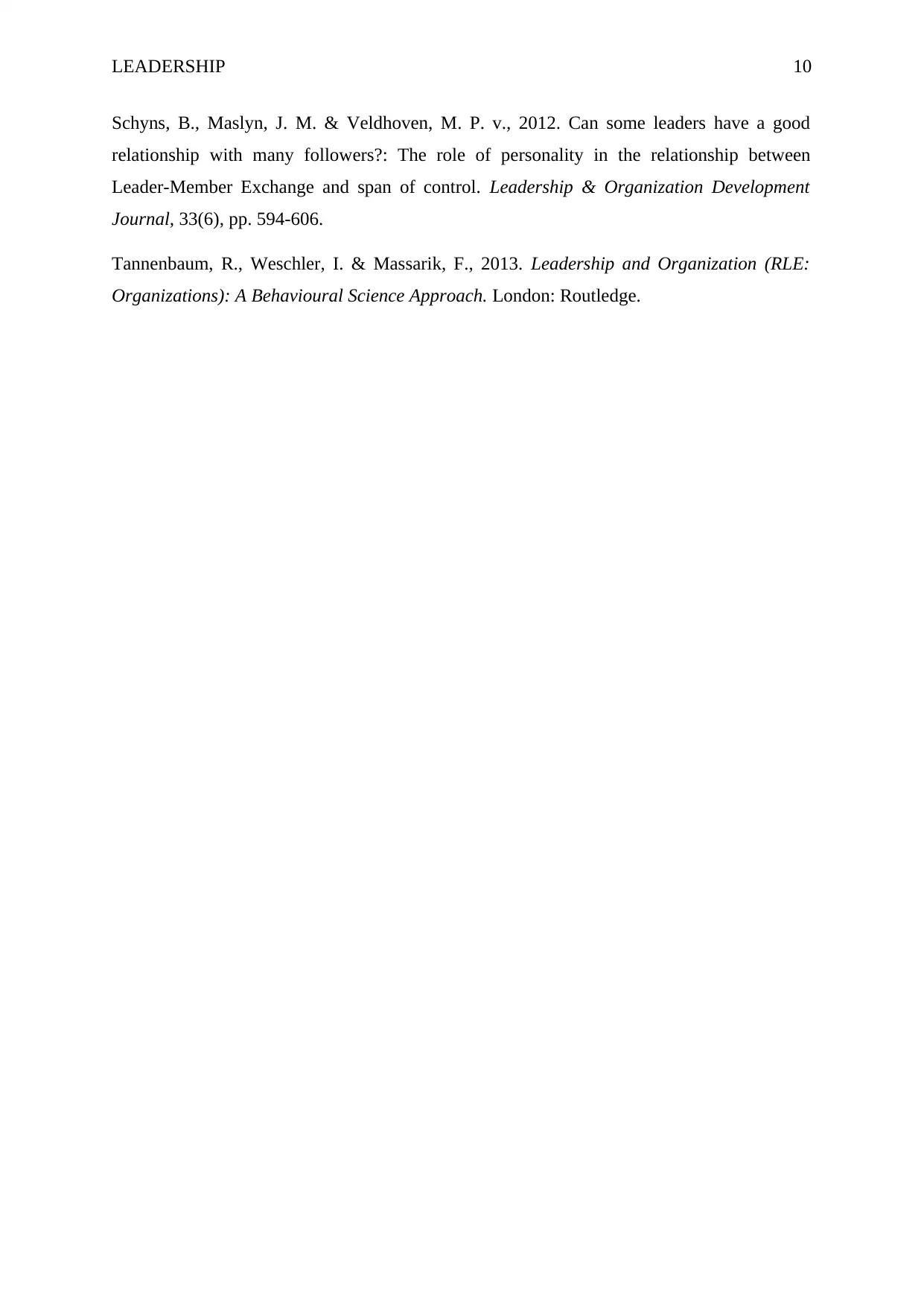
LEADERSHIP 10
Schyns, B., Maslyn, J. M. & Veldhoven, M. P. v., 2012. Can some leaders have a good
relationship with many followers?: The role of personality in the relationship between
Leader-Member Exchange and span of control. Leadership & Organization Development
Journal, 33(6), pp. 594-606.
Tannenbaum, R., Weschler, I. & Massarik, F., 2013. Leadership and Organization (RLE:
Organizations): A Behavioural Science Approach. London: Routledge.
Schyns, B., Maslyn, J. M. & Veldhoven, M. P. v., 2012. Can some leaders have a good
relationship with many followers?: The role of personality in the relationship between
Leader-Member Exchange and span of control. Leadership & Organization Development
Journal, 33(6), pp. 594-606.
Tannenbaum, R., Weschler, I. & Massarik, F., 2013. Leadership and Organization (RLE:
Organizations): A Behavioural Science Approach. London: Routledge.
1 out of 11
Related Documents
Your All-in-One AI-Powered Toolkit for Academic Success.
+13062052269
info@desklib.com
Available 24*7 on WhatsApp / Email
![[object Object]](/_next/static/media/star-bottom.7253800d.svg)
Unlock your academic potential
Copyright © 2020–2025 A2Z Services. All Rights Reserved. Developed and managed by ZUCOL.



